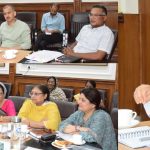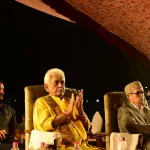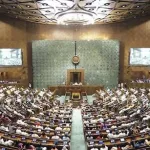In today’s rapidly evolving healthcare landscape, where public trust and engagement are constantly tested, healthcare institutions must find innovative ways to reach out to the community. One such bold initiative is the “Public Darbar” launched by the Director of SKIMS (Sher-i-Kashmir Institute of Medical Sciences) in Jammu and Kashmir. This initiative stands out as a much-needed step towards reshaping healthcare communication, enhancing transparency, and fostering active participation from the public.
The “Public Darbar” is designed as a innovative grievance redressal mechanism and a comprehensive platform where the public can engage directly with decision-makers at SKIMS. In an age where misinformation and skepticism about healthcare systems run high, this initiative creates a direct channel for addressing concerns, receiving feedback, and making healthcare delivery more responsive and patient-centered.
Public outreach is a critical aspect of healthcare governance. It is a means of not only communicating with the public but also empowering them by making them active participants in the decision-making process. With increasing reliance on digital tools and social media, healthcare outreach often tends to be reactive, rather than proactive. The “Public Darbar” initiative by SKIMS stands as a proactive, transparent, and inclusive model of engagement that marks a significant shift in how public institutions operate.
Why Public Health Outreach Matters in Healthcare
Public health outreach serves as a critical interface between healthcare systems and the community. Effective outreach efforts help bridge the gap between institutional practices and the real-world needs of patients and the general public. In times of information overload, misinformation, and rapidly changing health trends, it is essential for healthcare institutions to engage actively with the community to foster trust and understanding.
Healthcare is a field that impacts every individual, yet the decision-making processes and administrative procedures often remain distant or opaque to the public. This lack of transparency can fuel distrust, misinformation, and dissatisfaction, which ultimately hampers effective healthcare delivery. The “Public Darbar” addresses this by opening a direct communication channel between the public and the decision-makers at SKIMS, encouraging transparency and creating an environment where feedback is not only welcomed but also acted upon.
Genesis of the Public Darbar: Vision and Leadership
Every institutional reform begins with a vision, and the “Public Darbar” initiative at SKIMS is no exception. The idea was not born in isolation but emerged from a growing recognition within the institution that traditional communication models need to be reset had in a rapidly evolving healthcare ecosystem. The visionary leadership of the Director SKIMS whose commitment to transparency, patient-centered care, and public trust laid the foundation for the initiative.
The Director’s foresight reflects a nuanced understanding of both institutional responsibility and public engagement. “Public Darbar” was conceived as a platform to remove barriers between the public and policymakers, eliminating the opacity that often surrounds decision-making in large institutions. This shift from passive listening to active dialogue is a hallmark of effective leadership—one that prioritizes public well-being above institutional inertia.
Structure and Modality of the Public Darbar
A vision, however powerful, must be translated into a workable structure to make meaningful impact. What distinguishes the “Public Darbar” at SKIMS from sporadic outreach efforts is its institutional framework —a thoughtfully crafted, participatory setup that facilitates dialogue while ensuring measurable outcomes.
The “Public Darbar” is not a monologue from the top, nor a mere grievance session. It is a well-orchestrated interaction where every participant—be it a patient, healthcare worker, NGO representative, or trade leader—has a designated space to speak, be heard, and receive follow-up. The structure combines accessibility with accountability.
Held within the SKIMS premises the Darbar is open to all citizens. This openness ensures that even the most marginalized voices have a forum.
The SKIMS administration has ensured the presence of key officials during these interactions—departmental heads, senior staff , sectional heads of supportive services are authorized to respond on the spot & register for prompt resolution.
Public Reception and Stakeholder Involvement
The true measure of any public initiative lies in the response it generates. In the case of the “Public Darbar” at SKIMS, the reception has been nothing short of remarkable. The very first session witnessed overwhelming participation from diverse segments of society—patients and their attendants, local residents, healthcare workers, representatives from civil society, NGOs, trade leaders, and even retired healthcare professionals. This broad-based involvement reveals a powerful insight: people are eager to have their voices heard in healthcare decisions.
For many participants, this was their first-ever opportunity to speak directly with senior decision-makers in a major public health institution. The presence of the Director and other high-ranking officials during the session reinforced the seriousness of the platform and lent credibility to the process. The presence of senior administrators sent a powerful signal that the public’s concerns were valued.
Listening that Leads to Action
The real strength of any public initiative lies not in the number of attendees or length of sessions, but in the tangible impact it creates. The “Public Darbar” at SKIMS has already begun to yield visible results, proving that when institutions genuinely listen, they also learn—and when they learn, they can act decisively.
From its very first session, the Darbar set in motion a chain of corrective actions. Issues raised by participants were not shelved. The emphasis on accountability and follow-up was not only encouraging for the complainants, but it also sparked a renewed sense of responsibility among SKIMS officials.
For instance, grievances about delays in diagnostic procedures led to the realignment of patient flow. Complaints about sanitation lapses prompted a comprehensive hygiene audit. Feedback on the lack of patient information desks in key areas triggered the creation of help counters staffed with trained volunteers.
Sustaining the Momentum: Toward a New Culture of Governance
The success of the “Public Darbar” at SKIMS lies not only in its conception or its immediate impact. The key to its long-term effectiveness is sustaining the momentum and institutionalizing the culture of responsiveness it seeks to foster. This initiative is not just about one-off solutions to specific grievances but about creating a broader shift in governance that is more inclusive, transparent, and dynamic.
By encouraging sustained community engagement and establishing formal channels for ongoing feedback, the “Public Darbar” sets the foundation for a new healthcare culture—one that prioritizes dialogue, accountability, and patient-centered care. The challenge now lies in ensuring that the momentum generated in these early stages continues, evolving the platform into a permanent feature of SKIMS operations and embedding its values into the institution’s overall philosophy.
(The Author is Working as Assistant Director Public Relations SKIMS/SKIMS MC)








